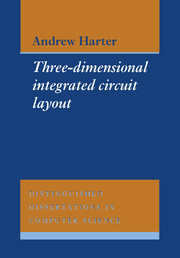Book contents
- Frontmatter
- Abstract
- Preface
- Contents
- List of Figures
- List of Plates
- List of Tables
- List of Algorithms
- Glossary of Terms
- 1 Introduction
- 2 Two-Dimensional Chip Design
- 3 Three-Dimensional Chip Technology
- 4 Three-Dimensional Circuit Topology
- 5 Three-Dimensional Cell Tessellation
- 6 Three-Dimensional Abutment System
- 7 Abutment System Configuration
- 8 Abutment System Evaluation
- 9 Conclusions
- A Layout Editor Configuration
- B Layout System Data Structures
- C Cell Description Rules
- D Circuits
- References
- Index
4 - Three-Dimensional Circuit Topology
Published online by Cambridge University Press: 05 May 2010
- Frontmatter
- Abstract
- Preface
- Contents
- List of Figures
- List of Plates
- List of Tables
- List of Algorithms
- Glossary of Terms
- 1 Introduction
- 2 Two-Dimensional Chip Design
- 3 Three-Dimensional Chip Technology
- 4 Three-Dimensional Circuit Topology
- 5 Three-Dimensional Cell Tessellation
- 6 Three-Dimensional Abutment System
- 7 Abutment System Configuration
- 8 Abutment System Evaluation
- 9 Conclusions
- A Layout Editor Configuration
- B Layout System Data Structures
- C Cell Description Rules
- D Circuits
- References
- Index
Summary
Wiring schemes
Introduction
A number of limitations imposed by the technology of three-dimensional integration have been mentioned. These limitations restrict the total number of transistors and the number of layers in which transistors can be constructed. However, for a given number of layers the topology of circuit layout is most profoundly affected by the availability and quality of wiring both within and between the layers.
For the layout problem, the distribution of wiring is determined by the edges in the physical layout graph, which is the initially empty spatial grid in which edges are wires and vertices are transistors or gates. The logical circuit graph specifies the structural connectivity of the circuit in terms of nodes and signals. Since layout consists of embedding the logical circuit graph into the physical layout graph, the pattern of edges in the physical graph has an effect on the compactness of the embedding. Contact and wiring techniques are now discussed.
Contact techniques
A range of contact techniques are available for three-dimensional structures, providing direct connection between diffusion, gate and wiring regions. Conventional contact methods which are used for connections within a single layer of transistors can be applied to create direct connections between layers of transistors. With the butting contact, regions are connected by contact with the wiring material which is particularly useful when the signal connected is required elsewhere in the circuit. In particular, connection can be formed between the gate and diffusion regions of a single transistor (Figure 4.1(a)), or a pair of stacked transistors (Figure 4.1(b)) [Kawamura 83].
- Type
- Chapter
- Information
- Three-Dimensional Integrated Circuit Layout , pp. 53 - 70Publisher: Cambridge University PressPrint publication year: 1991



